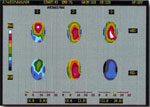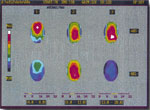Complex EEG Assessment of the “IQ Tutor” and the ABR “24 Minute Nap”
en français
DATA COLLECTION
EEG recordings were made from 19 surface electrodes in standard international 10-20 placement via an Electro-Cap electrode array and Electro-Gel conductive paste. The raw EEG signals were acquired via a Lexicor NeuroSearch 24 and digitalized and analyzed via NeuroSearch software (V151) run on a Cogni 35000 (386/33hz) computer. Recording was conducted during four conditions:
- (1) an eyes closed baseline condition,(2) while the subject was connected to the IQ Tutor via ear phones and LED glasses as the “sleep” program played,(3) while the subject listened to the “24 Minute Nap” tape via headphones, and(4) while the subject experienced the IQ Tutor “sleep” program and “24 Minute Nap” tape simultaneously. The subject for this assessment was a 43 year old white male psychotherapy patient with a long history of sleep disturbance including onset and early awakening insomnia. On the morning of the assessment he reported that his sleep pattern in the previous 24 hours had been “not good.” Although treated in the past with sleep aid medication including Halcyon he denied the use of any sleep inducing medications in the 72 hour period prior to the assessment.
RAW EEG
The eyes closed resting baseline record is well organized and consists of low amplitude alpha activity peaking at 8-10 cps in the posterior regions (01 and 02). The “24 Minute Nap” tape appeared to stimulate an increase in alpha amplitude while the IQ Tutor “Sleep Program” alone and the combination of the IQ Tutor and tape produced increases in alpha and theta activity with the greatest increase of theta occurring in the combined condition. The raw EEG of the IQ Tutor alone condition shows the alpha pattern giving way to bursts of theta. The combined condition shows the theta bursts lengthening with theta becoming the predominant wave form. Samples of raw EEG for each condition are attached.
TOPOGRAPHIC MAPS
The raw EEG was converted via Fast Fourrier Transform to the graphic representation of topographic “brain maps” that show the absolute (ABS) and relative (REL) location and distribution of Theta (4 – 8 Hz) Alpha (8 – 12 Hz) and Beta (12 – 20 Hz) activity. Maps were prepared for each of the four assessment conditions. The eyes closed baseline and the tape only maps are generally equivalent in revealing a predominant alpha pattern although the tape condition appears to have produced a more balanced right brain – left brain pattern and a higher alpha amplitude. The IQ Tutor Sleep program map, when compared with the baseline reflects an increase in slower theta activity. The map of the combined tape and IQ Tutor condition shows a predominant theta pattern.
Eyes Closed Baseline

24 Minute Nap

CONCLUSIONS
All three stimulus conditions produced changes from the baseline condition. The “24 Minute Nap” appeared to induce a general deepening of relaxation as evident in the increase of slower alpha and increased alpha amplitude. The IQ Tutor “Sleep” program alone appeared to stimulate a further slowing of the EEG as evident in the increase of theta activity. The subject commented that he began to have a “feeling of losing balance” during the IQ Tutor alone portion of the assessment. The combination of the IQ Tutor “Sleep” program with the “24 Minute Nap” appeared to have a synergistic effect evident in a substantial slowing of the EEG with theta as the predominant wave form as in the induction of sleep. The assessment subject commented that he was aware of “nodding out during the combined” condition and in fact had to be roused from an unconscious state at the conclusion of the assessment.DISCUSSION:The “24 Minute Nap” and the IQ Tutor “Sleep” Program appeared to adequately fulfill their intended purposes of assisting the test subject in achieving a sleep state. The “24 Minute Nap” used alone assisted the test subject in achieving a deepened state of relaxation. The IQ Tutor “Sleep” Program used alone seemed to further deepen the test subjects state of relaxation and began to initiate increased theta activity experienced by subject as a floating sensation.
The combination of the IQ Tutor “Sleep” Program and the “24 Minute Nap” tape appeared to provide a one-two punch that led to the onset of sustained theta bursts and the initiation of sleep.
DISCLAIMER
This assessment was conducted with one subject with a known history of sleep disturbance. The generalization of the results for this subject to other individuals with sleep problems or others interested in the use of an audio visual sleep aid must be made with caution. Further assessment with a statistically appropriate number of subjects would be required before making any “scientifically valid” claims for this tape or AV device.Dan Chartier, Ph.D.Ned Kelly, M.D.Medical Biofeedback Services, Inc.
8408 Glenwood Avenue, Raleigh, NC 27612



